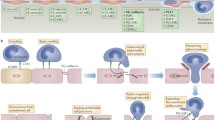Abstract
According to Morris and his colleagues the migration of lymphocytes from the blood into inflammatory sites is a morphologically similar process to the large scale migration of lymphocytes into the paracortex of lymph-nodes which occurs under normal conditions. Little is known of the nature of the selective interaction between lymphocytes and specialized endothelial cells although several investigators have tested the migratory properties of lymphocytes which have been treated in vitro with enzymes or lectins and injected i.v. Such results are difficult to inerpret because decreased lymph-node localization may be secondary to increased localization elsewhere.
To overcome these difficulties the mesenteric lymphnode chain of the rat was perfused at 37°C for 30–60 minutes with rat serum at 0.33 ml/min. When labelled lymphocytes were added to the perfusate the uptake of cells into the lymph-nodes was 2.13±0.63% of the number of which had passed through the preparation and this fraction was independent of the concentration in the perfusate over a wide range. No release of lymphocytes from the isolated node into the perfusate could be detected. Neuraminidase treated lymphocytes localized in the perfused lymph-node at least as well as did untreated lymphocytes in contrast to their deficient lymph-node localization following i.v. injection into intact recipients as originally found by Gesner. Other evidence has been found that the primary effect of neuraminidase treatment is to increase hepatic localization. Large lymphocytes migrate into the isolated node more readily than do small lymphocytes which is also in contrast to results in intact recipients. The migration of lymphocytes treated with trypsin or concanavalin A has also been studied.
Similar content being viewed by others
References
Gowans, J.L., and Knight, E.J.,The route of recirculation of lymphocytes in the rat, Proc. Roy. Soc. [B]159, 257 (1964).
Smith, J.B., McIntosh, G.H., and Morris, B.,The traffic of cells through tissues: a study of peripheral lymph in sheep, J. Anat.107, 87 (1970).
Smith, J.B., McIntosh, G.H., and Morris, B.,The migration of cells through chronically inflamed tissues, J. Pathol.100, 21 (1970).
Gesner, B.M., and Ginsburg, V.,Effect of glycosidases on the fate of transfused lymphocytes, Proc. nat. Acad. Sci.52, 750 (1964).
Woodruff, J.J., and Gesner, B.M.,The effect of neuraminidase on the fate of transfused lymphocytes, J. exp. Med.129, 551 (1969).
Woodruff, J.J., and Gesner, B.M.,Lymphocytes: Circulation altered by trypsin, Science161, 176 (1968).
Ford, W.L.,The immunological and migratory properties of the lymphocytes recirculating through the rat spleen, Br. J. exp. Path.50, 257 (1969).
Gillette, R.W., McKenzie, G.O., and Swanson, M.H.,Effect of convanavalin A on the homing of labelled T lymphocytes, J. Immunol.111, 1902 (1973).
Author information
Authors and Affiliations
Rights and permissions
About this article
Cite this article
Ford, W.L., Sedgely, M. The migration of lymphocytes across vascular endothelium. Agents and Actions 6, 248–250 (1976). https://doi.org/10.1007/BF01972216
Issue Date:
DOI: https://doi.org/10.1007/BF01972216




